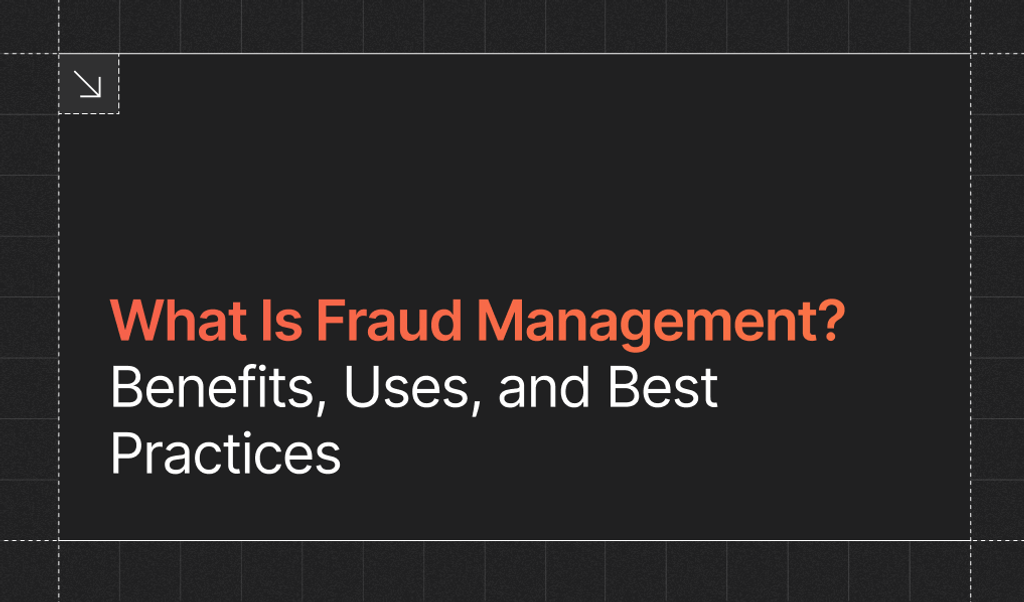Businesses like yours are increasingly vulnerable to fraud. Cybercriminals are constantly devising new schemes to siphon off funds. Protecting your company's finances and reputation from these threats is crucial, as the real cost of online fraud is severe.
Enter fraud analytics, a powerful ally in the fight against fraudulent activities.
By harnessing data analytics, you can enhance fraud detection and beef up your fraud prevention mechanisms.
Fraud analytics tools sift through massive volumes of transactions in real time. You can spot inconsistencies and suspicious fraud patterns that often go unnoticed by traditional security measures. You’re always one step ahead, minimizing the risk of fraud impacting your bottom line.
This article gives you everything you need to understand fraud analytics.
What is fraud analytics?
Fraud analytics is the application of data science and analytics techniques to recognize fraudulent transactions and dodgy behaviors in financial systems.
With the global fraud detection and prevention market expected to grow to $66.6 billion (USD) by 2028, you can expect fraud analytics to explode in the coming years.
The process begins with the collection and analysis of vast amounts of data. Machine learning and artificial intelligence (AI) are the brains behind this operation, parsing through data analysis to flag anything that looks suspicious.
By using predictive analytics, you can anticipate fraudulent tricks before they happen. You’re able to monitor your business and stay ahead of potential risks.
In other words, your business gains insights that aren’t just reactive but proactive. This way, you’re equipped to stop fraudsters in their tracks — saving your business from financial and reputational harm.
Benefits of using fraud analytics
Fraud analytics equips you with advanced tools to better protect your financial interests. Below, we’ll outline a number of benefits you’ll gain from using these tools.
Reduced financial losses from fraudulent transactions
Financial institutions that deploy advanced fraud detection systems can intercept and prevent fraudulent transactions. In turn, they protect their revenues.
This approach not only safeguards assets but also ensures you maintain customer trust in your business. Since people buy from businesses they know, like, and trust, your trustworthiness has a direct impact on your profit.
Bottom line: Your ability to detect and respond to fraudulent activity sooner rather than later can reduce financial damage and preserve your reputation.
Improved operational efficiency and detection of suspicious activity
Fraud analytics streamline the identification and investigation of strange activities, improving your operational efficiency. Your fraud management team can quickly pinpoint and scrutinize irregularities, ensuring prompt action.
Fast action reduces the time and resources spent on fraud investigations. Your team can then focus their time on other critical areas of your operation. Integrating automated fraud detection tools can further accelerate response times, minimizing the window of opportunity for fraudsters to exploit.
Identifying new patterns and trends
With access to a breadth of data and predictive models, you become adept at pattern recognition and trends in fraud. These insights enable you to stay ahead of the continuous evolution of fraudulent strategies.
As cybercriminals keep adapting their tactics, having a system in place that evolves with these trends helps you stay ahead. You’ll be prepared to thwart current fraudulent schemes and you’ll be ready for future threats. Long-term security and resilience against fraud is the goal here.
Proactive risk management and informed decision-making
Effective fraud risk management is proactive, not reactive. By using data analytics techniques, you can conduct a thorough risk assessment, anticipate potential threats, and make informed decisions to reinforce your defenses against fraud loss.
This proactive stance means implementing strategic defenses before fraud can occur, rather than just responding to incidents after they happen.
The integration of predictive analytics and machine learning models can enhance your ability to foresee and mitigate risks. According to Juniper Research, AI and machine learning will be non-negotiable in the future for providing a genuine ROI on fraud detection. This research expects AI to increase cost savings to $10.4 billion globally in 2027.
Techniques used in fraud analytics
Fraud analytics uses various techniques to interpret data and detect anomalies. Each approach we’ll highlight below offers unique insights and gives you a comprehensive assessment of fraud risk.
Descriptive analytics
Descriptive analytics involves summarizing historical data to identify patterns within transaction data and user behavior. If you're reviewing reports or dashboards, this is the initial layer of analytics.
Descriptive analytics relies on basic statistical techniques to curate data sets and ensure data quality is maintained. Common outputs include the calculation of averages, frequencies, and variations within your fraud data.
Diagnostic analytics
Once patterns are established, you dive deeper into the data sets with diagnostic analytics to discover the reasons behind specific events.
More complex analytics are involved, such as mining data for specific fraud indicators that can reveal fraudulent behaviors. The methodology might include examining cause and effect by using algorithms that dissect the relationships within the data.
Predictive analytics
Predictive analytics harnesses machine learning techniques and predictive models to forecast the likelihood of future fraud based on historical data.
By analyzing trends and patterns, you can identify potential risks before they turn into actual fraud. Machine learning algorithms are used to sift through massive volumes of data and detect subtle, complex fraud schemes.
Prescriptive analytics
Prescriptive analytics focuses on finding the best course of action for any given situation. This might involve machine learning algorithms that not only predict potential fraud but also suggest ways to prevent it.
By analyzing past incidents and outcomes, you can curate response strategies and establish proactive defenses against future fraud attempts.
How fraud analytics are used in protecting a business
Fraud analytics tools blend security measures and fraud detection techniques to safeguard online transactions and minimize loss from fraud. Let’s take a look at how this works.
Protecting online transactions
For online transactions, real-time monitoring and analytics reduce the risk of fraudulent activities. By analyzing customer data, IP addresses, and transaction patterns, fraud prevention solutions can flag unusual activities and provide a risk score.
This continuous monitoring ensures that businesses can immediately respond to potential threats, safeguarding both the company and its customers from financial harm.
The use of advanced algorithms and machine learning further refines this process, helping you optimize fraud detection, prevent identity theft, and minimize false alarms.
Preventing chargebacks
To combat chargebacks, analytics monitor inconsistencies in transaction behavior that might signal credit card fraud.
Businesses can reduce false positives and enhance trust with legitimate customers when they set thresholds for acceptable behavior and verify transactions using customer data. Regulations such as Know Your Customer (KYC) also help with this.
This targeted approach not only prevents revenue loss but also preserves the merchant-customer relationship by reducing wrongful declines. Implementing sophisticated fraud detection strategies will help you maintain a healthy balance between security and customer satisfaction.
Combating account takeover
Account takeover (ATO) prevention systems scrutinize login behaviors, such as irregular IP addresses or access times. They employ security measures like multi-factor authentication (MFA), which involves multiple layers of verification.
By analyzing behavioral data and patterns, businesses can detect and respond to ATO attempts early, preventing unauthorized access and protecting customer accounts. Proactive security measures are critical for maintaining user trust and ensuring the integrity of account information.
Detecting credit card fraud
Fraud analytics tools also clamp down on credit card fraud.
Any anomalous activity can trigger alerts by comparing transactions against established spending patterns and geographic locations. You can quickly mitigate and protect against unauthorized card use.
Most of these systems give you a detailed understanding of each customer's habits. So you can reduce the chances of fraud while ensuring legitimate transactions proceed smoothly.
Remember that credit card fraud remains a serious threat: Your business needs powerful analytics to prevent it.
Best practices for implementing the use of fraud analytics in an organization
Wondering how to bolster your defense against fraudulent activities by incorporating fraud analytics into your organization? Keep these best practices in mind:
- Integrate with an internal audit: Ensure your fraud analytics program is integrated with the internal audit function. This will promote a comprehensive evaluation of your controls and provide a robust fraud prevention mechanism.
- Conduct regular fraud risk assessments: Regularly analyzing your data helps you understand where you may be vulnerable to fraud. Stay one step ahead by identifying potential risks before they become actual issues.
- Implement robust fraud prevention systems: Choose and implement a fraud analytics tool that aligns with your organization's size and complexity. This system should scale with your organization and adapt to new threats as they emerge.
- Commit to compliance and training: Compliance isn't just about following rules; it's about understanding the why behind them. Invest in training your team to recognize fraud signals in channels like email and social media. Teach them how to use analytics tools effectively.
- Leverage data analytics: Analyze vast amounts of data quickly and accurately. Big data can be your best ally in detecting anomalies that signal fraud. Use advanced analytics to process and interpret your data effectively.
Using these practices will enhance your capability to prevent, detect, and respond to fraud, securing your organization's assets and reputation.
Harness the power of fraud analytics with Fingerprint
Fraud can be a considerable challenge, but with the right tools like analytics and device intelligence, you’re not defenseless.
Fingerprint helps you spot suspicious activities and halt fraud before it impacts your bottom line. Of course, it’s not just about saving money — it's also about maintaining the trust of your customers and the integrity of your brand.
Want to elevate your fraud prevention measures? Get in touch with Fingerprint today to learn how we can protect your business against fraud.
FAQ
You'll want to consider the following: integrating with an internal audit, conducting regular fraud risk assessments, implementing robust fraud prevention systems, a commitment to compliance and internal training, and leveraing analytics for overall efficiency.



